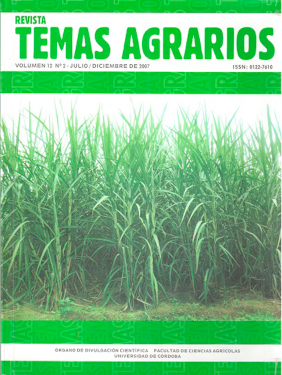Effect of a biofertilizer and the response to the waterlogging stress in sugarcane vitroplants, variety C120-78
Efecto de biofertilizante y estrés por hidromorfía en vitroplantas de caña de azúcar, variedad C120-78

This work is licensed under a Creative Commons Attribution-NonCommercial 4.0 International License.
Show authors biography
The soil flooding increased by the effects of global climatic change is a phenomenon that affected plants and microorganisms in many regions of the world. The presence of endophyte activity in sugarcane of Azospirillum brasilense strain´s can constitute a sustainable alternative due to the universal distribution of this bacterium and to its various beneficial effects on plant growth. In a Typic Haplustert soil of the Cauto´s River Valley, in the east region of Cuba, an experiment was established using a randomized blocks design, variety C120-78, obtained by in vitro culture, inoculated and without inoculating with Azospirillum brasilense strain 8 from INICA, under normal conditions and with flooded soil, with the objective of determining the influence of this bacterial strain on growth of the sugar cane plant cycle. It was demonstrated that the pol percentage cane, cane ton ha-1, pol ton ha-1 and the radical system growth at the twelve months of age, the presence of the bacteria in non flooded soil showed the best results, demonstrated that the low level oxygen in the soil is a restrictive element for the activity of this bacterial strain and the normal growth of the sugarcane.
Article visits 778 | PDF visits
Downloads
- Bothe, N.; Tennigkeit, J. y Eisbrenmer, G. 1981. Transformation of inorganic nitrogen by Azospirillum spp. Archives of Microbiology 130: 96-100.
- Correa, O.; Moccia, S. y Romero, A. 2002. Producción de plantines de tomate: Condiciones de aplicación de azospirillum sp. Proyecto UBACYT01/G009. Cátedra de Microbiología, Facultad de Agronomía. Universidad de Buenos Aires, Argentina.
- De Carvalho, C. e Ishida, F. 2002. Responses of young pijuayo plants (Bactris gasipaes Kunth) to flooding. Pesquisa Agropecuária Brasileira 37(9):1231- 1237.
- Deren, C.; Cherry, R. y Zinder, G. 1993. Effect of flooding on selected sugarcane clones. Journal American Society of Sugar Cane Technology 13:22-26.
- Drew, M. 1997. Oxygen deficiency and metabolism: injury and acclimation under hypoxia and anoxia. Annual Review of Plant Physiology and Plant Molecular Biology 48:223-250.
- Driessen, P.; Deckers, J.; Sparargaren, O. y Nachtergaele, F. 2001. Lecture notes on the major soils of the world. World Soil Resources Reports, 94, FAO, Roma, 334 pp.
- Eckert, B.; Weber, O.; Kirchhof, G.; Halbritter, A.; Stofields, M. y Hartman, A. 2001. Azospirillum doebereineare sp. nov., a nitrogen - fixing bacterium associated with the C(4) - grass Miscanthus. International Journal of Systematic and Evolutionary Microbiology 51:17-26.
- Fida, M.; Alam. H.; Jabber, M.; Begur, M y Miah, M. 2003. Effects of waterlogging on juice quality and yield of sugarcane. Pakistan Journal of Biological Sciences 6(3):1151- 1155.
- Gabriel, K. 1971. The biplot graphic display of matrices with applications to principal components analysis. Biometrika 58(3):453-467.
- Gower, J. y Ross, P. 1969. Minimun spanning tress and single cluster analysis. Applied Statistics 18:54-64.
- Hadas, R. y Okon, V. 1987. Effect of Azospirillum brasilense inoculation on root morphology and respitation in tomato seedlings. Biology and Fertility of Soils 5(3):241-247.
- Hotelling, H. 1933. Analysis of a complex of statistical variables into principal components. Journal of Educational Psychology 24:498-520.
- Humbert, R. 1965. El cultivo de la caña de azúcar. Editorial Universitaria, La Habana, 785 pp.
- INICA. 2002. Normas y procedimientos del programa de mejoramiento genético de la caña de azúcar en Cuba. Boletín No. 1 Cuba & Caña-INICA, Instituto Nacional de Investigaciones de la Caña de Azúcar, La Habana, 315 pp.
- Inman-Bamber, N.; Bonnett, G.; Smith, D. y Thorburn, P. 2004: Sugarcane physiology: Integrating from cell to crop to advance sugarcane production. Field Crops Research 92(2-3):115-117.
- Kolensnikov, V. 1971. The root system of fruit plant. MIR, Moscow, 269 pp.
- Krautman, S. 1959. Observacoes do sistema radicular da Cana IANE-C46117 en solo de Baixada (Varzea). Boletín Técnico do Instituto Agronómico do Norte 6:25-31.
- Martín, J.; Gálvez, G.; De Armas, R.; Espinosa, R.; Vigoa, R. y León, A. 1987. La Caña de Azúcar en Cuba. Editorial Científico Técnica, La Habana, 612pp.
- Morrison, D. 1979. Multivariate statistics. D. F. Morrison, John Wiley and Sons, New York, 414 pp.
- Pérez, J. y Casas, M. 2005. Estudio de la interacción planta - Azospirilum en el cultivo caña de azúcar (Saccharum spp. híb.). Cultivos Tropicales 26(4):13-19.
- Saad, M.; Ali-Sabuddin, A.; Yunus, A. y Shamsuddin, Z. 1996. Performance of sweetpotato variety OP MSS 5 inoculated with Azospirillum on sandy ten tilling soil. Sweetpotato 2:107-119 SAS Institute. 2000. Statistical Analysis System.
- SAS Institute. User´s guide. Version 8.0. SAS Institute, Inc., Cary, North Carolina, 3884 pp.
- Soil Survey Staff. 2003. Claves para la taxonomía de suelos. Colegio de Postgraduados, Chapingo, 306 pp.
- Vlassak, K y Reyaders, L. 1977. Associative dinitrogen fixiation in temperature regions. In isotipcs in biological dinitrogen fixiation. Proceedings of the Advisory Group, International Atomic Energy, Viena, p 71.
- Vose, B. 1983. Developments in nonlegume N2-fixing systems. Canadian Journal of Microbiology 29:837-849.




















